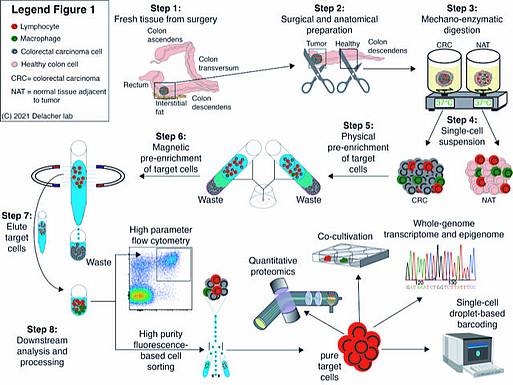Methods used in the Delacher laboratory
In the Delacher Lab, we are using a wide variety of experimental and bioinformatic methods. For this, we are working together with collaboration partners from the Institute, the University Medical Center, as well as other researchers in and outside of Germany. The figure below shows a typical workflow in our lab:
1) We receive fresh tissue from surgical procedures performed at the University Medical Center in Mainz or other Medical Centers in the area
2) In collaboration with the department of pathology, healthy and neoplastic tissue are identified and anatomically separated
3) Tissues are digested in a mixture of enzymes in order to isolate single cells from the tissue
4) The single-cell suspension can now be further separated into subsets
5) Via physical separation methods such as gradient centrifugation or filtration, immune cell subsets can be separated from each other
6) We then use magnetic separation methods to retain target cells using a strong magnetic field, while non-target cells can be washed off
7) Target cells can be eluted and analyzed, e.g. using flow cytometry or microscopy
8) To analyze target cells on a molecular level, they are sorted according to their surface characteristics with a fluorescence activated cell sorting machine. The now extremely pure cell population can be used for detailed downstream analyses, e.g.
1) We receive fresh tissue from surgical procedures performed at the University Medical Center in Mainz or other Medical Centers in the area
2) In collaboration with the department of pathology, healthy and neoplastic tissue are identified and anatomically separated
3) Tissues are digested in a mixture of enzymes in order to isolate single cells from the tissue
4) The single-cell suspension can now be further separated into subsets
5) Via physical separation methods such as gradient centrifugation or filtration, immune cell subsets can be separated from each other
6) We then use magnetic separation methods to retain target cells using a strong magnetic field, while non-target cells can be washed off
7) Target cells can be eluted and analyzed, e.g. using flow cytometry or microscopy
8) To analyze target cells on a molecular level, they are sorted according to their surface characteristics with a fluorescence activated cell sorting machine. The now extremely pure cell population can be used for detailed downstream analyses, e.g.
- Droplet-based single cell barcoding, which allows for single-cell gene expression analysis or single-cell chromatin accessibility analysis. In addition, we can track T cell clones via analysis of the T cell receptor, the "molecular barcode" of T cells
- Gene expression analysis via RNA-Sequencing
- Analysis of genome-wide DNA methylation patterns
- Identification of secreted proteins via quantitative mass spectrometry
- Cell culture experiments and co-cultures with other cell types
